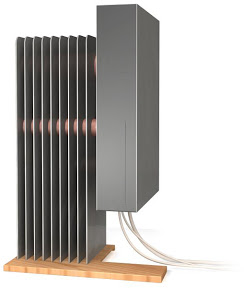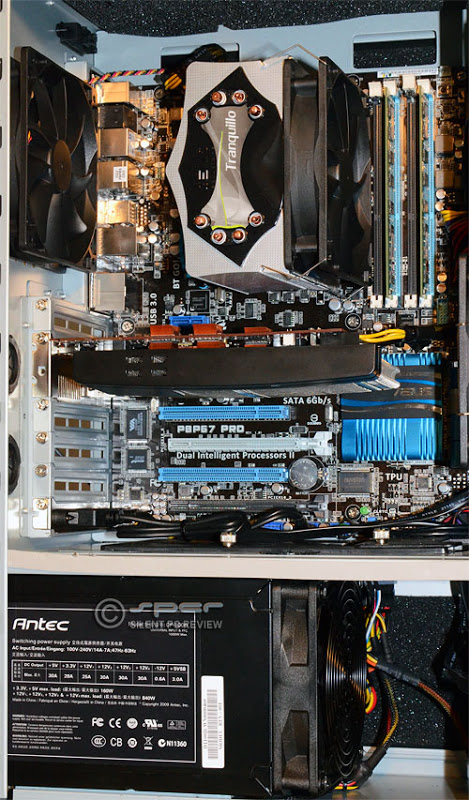The benchmark of silence with maximum performance
 As was to be expected, the new Intel Sandy Bridge processors, not having time to really get into the shops, riveted the attention of connoisseurs of silence. This is no accident, because according to the test results, they are several degrees colder than their predecessors in the first series of the Core iX. Therefore, it is easier to cool them.
As was to be expected, the new Intel Sandy Bridge processors, not having time to really get into the shops, riveted the attention of connoisseurs of silence. This is no accident, because according to the test results, they are several degrees colder than their predecessors in the first series of the Core iX. Therefore, it is easier to cool them.Probably, many are familiar with one of the most consistent fighters with noise - a resource with a speaker called Silent PC Review.
The other day they updated their configuration of the powerful silent system block SPCR Edition to version 3 (I just like the picture above and is connected to the article only with a general theme).
')
Actually, the details can be viewed at the link provided, but since English resource, here are the key points.
First, the configuration itself is:
The Asus P8P67 Pro motherboard is on a new 1155 socket. Many rightly cursed Intel for another socket change, but the reason for this is: the power of the cores and the graphics processor, which are now on the same chip, is done on separate buses This, in fact, made it possible to more effectively manage power consumption.
Intel Core i7 2600K Quad-core 3.4GHz processor. Peak power consumption 95 watts. This is still the fastest processor in the line with integrated graphics HD 3000, which, by the way, is not inferior to the discrete AMD 5450.
Video card PowerColor Radeon HD5750 1Gb Silent . Despite the high-quality integrated graphics, they still delivered a faster discrete card with passive cooling.
Hard drives System: SSD Intel X25-M Gen2 120 GB. For silent configuration expected. Data storage: WD Caviar Green 2 TB. Also almost silent.
Antec P183 case . From the two-year experience of using the P182, I can say that it is a great case for a silent system.
Antec CP-850 power supply. I do not know why such a powerful power supply unit is needed - the system consumes a little more than 200 watts at maximum load ( for doubters ). Probably, on a more powerful unit, the fan turns slower with low loads. Personally, I would instead put Enermax Modu 87+, but I will not argue with recognized experts :)
CPU cooling : Gelid Tranquilo radiator and Scythe Slip Stream 120 fan.
Cooling other components - two more Scythe Slip Stream 120 fans. I don’t know why they needed two more fans. As far as I understand, the goal was to provide not only silence, but also effective cooling.
Important notes on silence
1. Both case fans work from 5 volts.
2. The fan speed curve on the processor is configured manually instead of the “Silent” profile in the BIOS (who knows how to do this?). They turned out that at maximum load the fan rotates only 30% faster than when the processor is idle.
3. Some additional settings were made in Windows 7, but they are optional.
4. They modified the case with their own “acoustic package” (seen in the photo on the left):

Here's what happened in the end:

Test results
1. Full load. Temperature: CPU 69 ° C, GPU 82 ° C, HDD 33 ° C. The maximum consumption of the entire system is 215 watts. The noise level in 1 meter from the system is 12.5 dB, in 60 cm - 15 dB.
2. Playing HD-video 1080p. Temperature: CPU 35 ~ 38 ° C, GPU 42 ~ 48 ° C, HDD 32 ° C. The maximum consumption of the entire system is 86 watts. The noise level in 1 meter from the system is 11 dB, in 60 cm - 12 dB.
2. Inactivity of the system. Temperature: CPU 30 ° C, GPU 40 ° C, HDD 32 ° C. The maximum consumption of the entire system is 68 watts. The noise level in 1 meter from the system is 11 dB, in 60 cm - 12 dB.
Note that the noise levels when playing HD video and during inactivity are the same.
Well, about the price. As I understand it, SPCR certifies production for Puget Systems. The configuration tested above costs $ 2463 , which of course is quite a lot. However, things "under the order" always cost dearly. Describing the configuration, I forgot to mention 8 GB of memory, a Blu-ray drive and the pre-installed Windows 7 Home Premium included.
After releasing Sandy Bridge, Intel, as usual, has something else up its sleeve. By the end of the year, the Ivy Bridge processors should come out - the process will be 22 nm , the integrated graphics will be greatly accelerated.
So, as usual, there is a dilemma - to wait for cooler and faster processors or to assemble a silent system from what is now - is also not the worst option. It all depends on the goals.
Source: https://habr.com/ru/post/112132/
All Articles